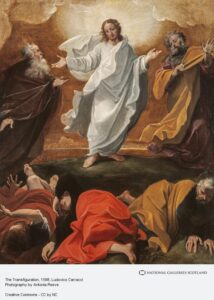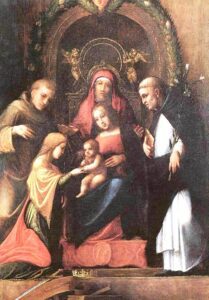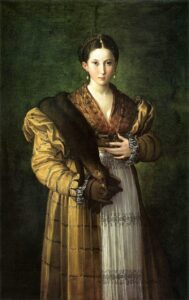SUMMARY: An impressive exhibition presents the work of Italian artists who congregated in the Emilian town of Parma. “The Age of Correggio and the Carracci: Emilian Painting of the Sixteenth and Seventeenth Centuries1’ reveals technical virtuosity, exciting imagery and emotional intensity on busy canvases — a combination that can appeal to those fatigued by the austerity of modern art.

Michelangelo, Leonardo, Raphael. Their names evoke a network of associations, images, even personalities. These Italian Renaissance artists fill niches in our 20th century cultural pantheon with a more solid presence and a more meaningful contribution than many of our contemporary cultural heroes.
Now we have a major old master exhibition with a completely unfamiliar cast of characters — the giant exhibition, at Washington’s National Gallery of Art, of works by Northern Italian Mannerist and Baroque old masters. The two names in the show’s title, “The Age of Correggio and the Carracci: Emilian Painting of the Sixteenth and Seventeenth Centuries,” will be ciphers to the average American. Included are 200 colorful, turbulent paintings by artists who pioneered revolutionary ideas about what constituted excellence in art but who went out of fashion some 185 years ago.
Perhaps the loveliest works in the show are also among the rarest — two extraordinarily lovely religious paintings by the founder of Emilian high Renaissance style, Antonio Allegri, called Correggio. (He was born in the town of Correggio but did most of his great ceiling frescoes and easel paintings in Parma,) Painted as a pair in the early 1520s for the church of San Giovanni Evangelista in Parma, ‘The Lamentation” and “The Martyrdom of Four Saints” have the luminous clear color, the fluid, graceful contours, and the strange erotic tension between violent subject matter and tenderly sensual treatment typical of Correggio. These works are like fixed points of reference throughout the show; in the succeeding two centuries Italian artists returned again and again to Parma to reabsorb the lessons of Correggio’s unique style. But the exhibition’s primary action revolves around the three Carraccis — Agostino, his brother Annibale and their cousin Ludovico. In 1582 they founded an academy in their home city of Bologna, capital of Emilia (a province of Northern Italy). This momentous event ushered in a revolution in Italian art.
Annibale’s startlingly modern painting of a butcher shop (circa 1583) reveals the back-to-nature ideas behind the Carracci reform. The slice-of-life viewpoint, the vigorous painting of hanging hunks of meat, the informal poses of the two knife–bearing butchers might have been done in 19th century France.
Not only did the Carraccis revive drawing from the model in their private academy, they also taught the fundamentals of music theory, architecture and aesthetics, bringing in learned men from the University of Bologna for lectures and discussions. By the end of the second decade of the 17th century, Bologna had superseded Rome as the center of Italian art.
In fact, the Carraccis and their proteges, Guido Reni, Francesco Albani, Domenichino and Guercino (all represented in depth in the show), were once thought to be in the same league as Raphael and Leonardo. The art-loving Philippe II, due d’Orleans, regent of France from 1715 to 1723, prized their lush, action-filled canvases. Engravings based on their pictures spread the Italians’ fame throughout Europe.
But their stock plummeted with the rise of romanticism in the 19th century. Gesturing saints with billowy drapery and bouncy, busty nymphs chased by Ieching satyrs went out. The eccentric, the intimate and the mystical came in. Henry Fuseli, the Blakean English painter, launched a typically romantic diatribe against the Baroque excesses of the Carraccis when he wrote in 1801: “How shall we classify someone [Annibale CarracciJ who, with the Sistine Chapel and the Vatican before his eyes, crams the seal of religious austerity and episcopal dignity with a chaotic congeries of banal fables and orgiastic rowdiness.”
By mid-19th century, painting in the Italian grand style was so completely out of favor that even Raphael did not escape censure. Artists like the pre-Raphaelites had eyes only for the simplicity and pious naturalism of earlier Renaissance painters. In the 20th century, the success of Impressionism, Cubism and other modernist movements only increased contemporary distaste for the “orgiastic rowdiness” of grand-style Italian painting.
But the pendulum is swinging the other way. Over the past few years, a series of exhibitions in the United States has focused attention on various aspects of Italian Baroque. The fascinating Caravaggio was the first of the Italian Baroque masters to be revived. “Painting in Naples from Caravaggio to Giordano,” mounted by the National Gallery in 1983, and “The Age of Caravaggio,” at New York’s Metropolitan Museum of Art in 1985, attracted large crowds. British movie maker Derek Jarman romanticized Caravaggio’s violent life and death.

Now it is the turn of the Emilians. The present show opened last fall to great acclaim in Bologna, where sentiment for these artists naturally runs high. As the first exhibition to focus exclusively on the art of Emilia during its period of greatest influence and renown, it has worldwide importance for art history. In fact, the project is an international effort, with catalog entries written by scholars from all over Europe and the United States. Unfortunately, the weighty catalog is of very uneven quality, with far too much emphasis on art history for the average reader. One can get more specific information on the Carraccis’ lives, for example, from their biographies in the catalog for “The Age of Caravaggio.”
In part, the present revival of Italian Baroque painting is due to naked market forces. Other great periods of art — Renaissance, Northern Renaissance, Dutch and Spanish Baroque, Impressionism — are unavailable or priced out of sight in the multiple millions of dollars. Major paintings by Emilian artists arc still available at the relatively affordable prices of a few hundred thousand dollars or so. Museums and collectors are snatching these paintings up before their prices soar.
But also the market for Italian Baroque benefits from the cyclic swings of taste. Fatigue with modernist austerity has opened many eyes to the pleasures of a style that combines virtuosic technical skill, rich painterly surfaces, action-packed imagery and emotional intensity. Emilian “orgiastic rowdiness’’ appeals to a postmodern sensibility, and the devout fervor of its religious paintings has attracted born-again Christians. (Bob Jones University holds a major collection of Italian Baroque paintings.)
Thus the show offers a prospect that is alternately exhilarating and intimidating. It is exciting to be shown firsthand so much unfamiliar art carrying such a modest amount of contemporary cultural baggage. At least in the United States, canons of good taste have yet to be established for these artists. If one is irritated by the exaggerated forms of Parmigianino but intrigued by the droll fantasies of Dosso Dossi, so much the better. Spend more time with Dossi. One has to develop favorites to make any sense of an exhibition this size.
On the other hand, there is a limit to enjoyment of endless second-rate variations on mythic and religious themes. Particularly in the 16th century Mannerist section of the show, one sometimes has the impression that visitors are being tricked into going through the same gallery over and over. Increased exposure will not make Bertoia’s languid nudes or Denys Calvært’s candy-box angels more palatable. Interestingly, National Gallery chief curator Sydney Freedberg had planned to mount a show of only 16th century Emilian art. But when he learned that Sir John Pope-Hennessey, consultative chairman of the department of European paintings at the Metropolitan Museum of Art, was in the early stages of organizing a 17th century exhibition of Emilian art, Freedberg expanded his concept. The final blockbuster version has three organizers: Freedberg, Hennessey and Andrea Emiliani, director of the Pinacoteca Nazionale in Bologna.

After “The Age of Correggio and the Carracci” closes at the National Gallery Feb. 16, it will travel to the Metropolitan Museum of Art. in Washington it splits comfortably into distinct halves, separated by the West Building’s Garden Court, where several of the larger altarpieces are beautifully installed.
It is in the first half of the exhibition, devoted to the 16th century, that one can see the most dramatic revolution in style. Two paintings of the same subject, “The Conversion of St. Paul,” give some idea of the profound changes Italian painting went through during this period. The earlier was painted in 1527 by Girolamo Francesco Mazzola, an important Mannerist who was called Parmigianino for the town of Parma, his birthplace.
The Renaissance ideal of clarity is still manifest in Parmigianino’s dramatic picture of rearing white horse, fallen rider and luminous distant landscape. But the proportions of the horse have been exaggerated and refined to heighten the impression of its power and grace. The animal turns its elegant head toward the viewer with a brilliant gaze, as if it fully understood the significance of St. Paul’s conversion to Christianity.
It is a marvelous picture, but the underlying rationale has little to do with the scientific curiosity, human-centered philosophy and classical balance that powered the Renaissance. Parmigianino takes perspective and anatomy for granted. He wants to see how he can manipulate them to achieve a more emotional, more spiritual expression. One suspects that the sack of Rome in 1527, with its disillusioning aftermath, had a devastating effect on the artist. He had gone to the papal city as a young man of 21 a decade or so after Michelangelo completed the Sistine Chapel and Raphael painted the Vatican Stanze. Parmigianino was lucky enough to secure the patronage of Pope Clement VII. Three years later his world and his future collapsed. He was forced to flee first to Bologna, where he unleashed his new anti-Renaissance style, and then back to Parma, where experiments with alchemy proved his undoing.
Even more important than the sack of Rome in changing the basic premises of Italian art during the 16th century was the Catholic response to the Protestant Reformation. The Council of Trent, convened 1545-1563, attacked not only the laxity and corruption of the clergy but also the way artists had been presenting the scriptures to the public. Nudity and pagan figures were proscribed for religious altarpieces. The new emphasis was on the directness and accessibility of the religious message.
Ludovico Carracci’s “Conversion of St. Paul,” painted in 1587-88, some 60 years after Parmigianino’s picture, incorporates the new ideas. The scene is painted just as it might have occurred during a stormy sunset on the road to Damascus. Saul of Tarsus (who became St. Paul) has just fallen from his horse, and his confused and alarmed followers recoil and attempt to calm their horses. A man’s leg moving off the field of vision at the right gives the picture an almost snapshot effect.

One can see a faint echo of Parmigianino’s painting in the way the horse turns his head, but the emotional focus is on the different psychological reactions of the men to the brilliant heavenly vision above. The use of strong lights and darks to lend drama and meaning to the narrative was to become a hallmark of the Baroque.
Although Annibale Carracci, with his more classicizing style, has been the best- known of the Carracci trio, this exhibition makes a strong case for Ludovico as the more expressive and original artist. A painting like “Saint Sebastian Thrown into the Cloaca Maxima” is absolutely haunting in the way Ludovico has used light to separate the humanity of the dead saint from the bureaucratic anonymity of the Roman soldiers who toss him into the Roman sewer like a sack of flour.
The second half of the show focuses on the 17th century followers and assistants of the Carraccis — the harmony-loving Domenichino (unfortunately, his great painting of St. Jerome will be seen in New York only); Guido Reni, who changes in midcareer from a supremely graceful paganism to pale, ethereal devotional art; and the passionate and powerful Guercino, who consciously followed the lead of Ludovico in his use of chiaroscuro.
Their works will certainly not be equally appealing to everyone. Clearly late Guido Reni is an acquired taste. But judging on the evidence of this show, the Emilians’ revival is long overdue. Many of the paintings on view have been newly cleaned with the financial and scientific aid of the Montedison Group of Italy. With the removal of layers of dirty varnish, even paintings by lesser-known Emilians such as Bartolomeo Schedoni emerge as brilliantly colored, with a wonderfully crisp handling of paint.
Most impressive are the consistently high standards the Emilians set for themselves. Their art reflects their deep respect for learning and technical skill and their desire to communicate religious truths in a direct and human way. It was this tradition of excellence that sustained the Emilians for almost a century. In light of their works, perhaps it is time to rethink the always pejorative use of the word “academic.”
Jane Addams Allen 1987
